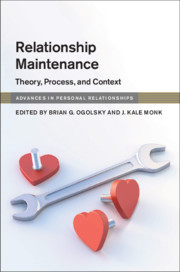Book contents
- Relationship Maintenance
- Advances in Personal Relationships
- Relationship Maintenance
- Copyright page
- Contents
- Tables
- Figures
- Contributors
- Part I Introduction
- Part II Theories of Relationship Maintenance
- Part III Processes of Relationship Maintenance
- Part IV The Social Context of Relationship Maintenance
- 14 Gender and Race Perspectives on Relationship Maintenance
- 15 Relationship Maintenance across Cultural Groups
- 16 Relationship Maintenance in the Age of Technology
- 17 Relationship Maintenance across the Life Course
- 18 Relationship Maintenance in Couple Therapy and Relationship Education
- Part V Conclusion
- Index
- References
16 - Relationship Maintenance in the Age of Technology
from Part IV - The Social Context of Relationship Maintenance
Published online by Cambridge University Press: 02 December 2019
- Relationship Maintenance
- Advances in Personal Relationships
- Relationship Maintenance
- Copyright page
- Contents
- Tables
- Figures
- Contributors
- Part I Introduction
- Part II Theories of Relationship Maintenance
- Part III Processes of Relationship Maintenance
- Part IV The Social Context of Relationship Maintenance
- 14 Gender and Race Perspectives on Relationship Maintenance
- 15 Relationship Maintenance across Cultural Groups
- 16 Relationship Maintenance in the Age of Technology
- 17 Relationship Maintenance across the Life Course
- 18 Relationship Maintenance in Couple Therapy and Relationship Education
- Part V Conclusion
- Index
- References
Summary
This chapter examines how computers and smartphones are used with (or instead of) face-to-face (F2F) interactions for relationship maintenance. After explicating two different definitions of the phrase “relationship maintenance,” we summarize research on the role of particular communication technologies in relationship maintenance. We argue that much contemporary relationship maintenance in romantic relationships occurs in mixed-media relationships, which occur when the “parties conduct in whole or in part through the use of multiple media, including F2F” (Parks). The primary focus of this chapter is on the maintenance of romantic relationships, yet we also review research on other types of relationships when the processes examined seem applicable to close relationships more broadly. We conclude with several important points for future research on relational maintenance and communication technologies, including recognizing that (a) even though technologies can help people maintain their relationships, they also can create burdens and problems; (b) the way people use technologies influences the effects of those technologies in relationships; (c) there is a need for more research on the specific behaviors using technologies in romantic relationships; and (d) even with the rise of communication technologies, face-to-face maintenance behaviors remain important.
Keywords
- Type
- Chapter
- Information
- Relationship MaintenanceTheory, Process, and Context, pp. 304 - 322Publisher: Cambridge University PressPrint publication year: 2019
References
- 3
- Cited by



